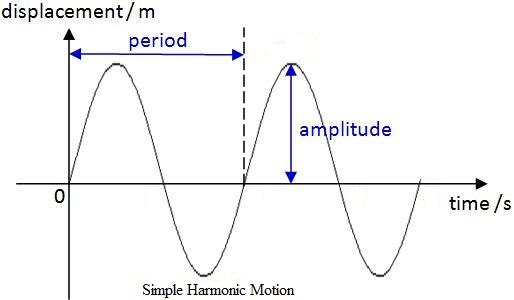Answer
442.5k+ views
Hint:Two particles tend to execute simple harmonic motion of same amplitude and same frequency. Hence, the equation of simple harmonic motion of both of the particles are the same. It is given that; the both the particles have displacement equal to half of the amplitude of the wave. Hence, both the particles have the same displacement. By substituting the displacement value in the equation simple harmonic motion, the phase values can be obtained. Using the two-phase values, the phase difference between the waves can be calculated.
Useful formula:
The equation of simple harmonic motion (SHM) is given by,
$y = A\sin \left( {\omega t + \phi } \right)$
Where, $y$ is the displacement of the particle, $A$ is the amplitude of the wave and $\left( {\omega t + \phi } \right)$ is the phase angle of the wave.
Complete step by step answer:
Given data:
The displacement of the wave is equal to one half of the amplitude of the wave.
Hence, $y = \dfrac{A}{2}$

Since, both of the particles are executing the same simple harmonic motion (SHM) with same amplitude and same frequency, then the equation of the SHM for both the particles is the same. It is given by,
$y = A\sin \left( {\omega t + \phi } \right)\;......................................\left( 1 \right)$
And it is given that the displacement of both the particles is equal to one half of the amplitude of the waves.
Hence, the displacement of the particles $y = \dfrac{A}{2}$
Substituting the displacement value in the equation (1), we get
$
\dfrac{A}{2} = A\sin \left( {\omega t + \phi } \right) \\
\sin \left( {\omega t + \phi } \right) = \dfrac{A}{{2A}} \\
\sin \left( {\omega t + \phi } \right) = \dfrac{1}{2} \\
$
Taking the term $\sin $ to the RHS of the equation,
$\omega t + \phi = {\sin ^{ - 1}}\left( {\dfrac{1}{2}} \right)$
Since, ${\sin ^{ - 1}}\left( {\dfrac{1}{2}} \right) = {30^ \circ }\left( {or} \right){150^ \circ }$
Hence,
$\omega t + \phi = {30^ \circ }$ (or) $\omega t + \phi = {150^ \circ }$
Thus, the phase angle of the first wave is ${30^ \circ }$ and the phase angle of the second wave is ${150^ \circ }$.
So, the phase difference between the two particles is ${150^ \circ } - {30^ \circ } = {120^ \circ }$
Hence, the option (C) is correct.
Note:
Even though the two particles execute the same simple harmonic motion with same amplitude and same frequency but they are executing in opposite directions. The phase difference between the two particle waves is ${120^ \circ }$, it is clear that the two particles are moving in different directions.
Useful formula:
The equation of simple harmonic motion (SHM) is given by,
$y = A\sin \left( {\omega t + \phi } \right)$
Where, $y$ is the displacement of the particle, $A$ is the amplitude of the wave and $\left( {\omega t + \phi } \right)$ is the phase angle of the wave.
Complete step by step answer:
Given data:
The displacement of the wave is equal to one half of the amplitude of the wave.
Hence, $y = \dfrac{A}{2}$

Since, both of the particles are executing the same simple harmonic motion (SHM) with same amplitude and same frequency, then the equation of the SHM for both the particles is the same. It is given by,
$y = A\sin \left( {\omega t + \phi } \right)\;......................................\left( 1 \right)$
And it is given that the displacement of both the particles is equal to one half of the amplitude of the waves.
Hence, the displacement of the particles $y = \dfrac{A}{2}$
Substituting the displacement value in the equation (1), we get
$
\dfrac{A}{2} = A\sin \left( {\omega t + \phi } \right) \\
\sin \left( {\omega t + \phi } \right) = \dfrac{A}{{2A}} \\
\sin \left( {\omega t + \phi } \right) = \dfrac{1}{2} \\
$
Taking the term $\sin $ to the RHS of the equation,
$\omega t + \phi = {\sin ^{ - 1}}\left( {\dfrac{1}{2}} \right)$
Since, ${\sin ^{ - 1}}\left( {\dfrac{1}{2}} \right) = {30^ \circ }\left( {or} \right){150^ \circ }$
Hence,
$\omega t + \phi = {30^ \circ }$ (or) $\omega t + \phi = {150^ \circ }$
Thus, the phase angle of the first wave is ${30^ \circ }$ and the phase angle of the second wave is ${150^ \circ }$.
So, the phase difference between the two particles is ${150^ \circ } - {30^ \circ } = {120^ \circ }$
Hence, the option (C) is correct.
Note:
Even though the two particles execute the same simple harmonic motion with same amplitude and same frequency but they are executing in opposite directions. The phase difference between the two particle waves is ${120^ \circ }$, it is clear that the two particles are moving in different directions.
Recently Updated Pages
Mark and label the given geoinformation on the outline class 11 social science CBSE

When people say No pun intended what does that mea class 8 english CBSE

Name the states which share their boundary with Indias class 9 social science CBSE

Give an account of the Northern Plains of India class 9 social science CBSE

Change the following sentences into negative and interrogative class 10 english CBSE

Advantages and disadvantages of science

Trending doubts
Which are the Top 10 Largest Countries of the World?

Difference between Prokaryotic cell and Eukaryotic class 11 biology CBSE

Fill the blanks with the suitable prepositions 1 The class 9 english CBSE

Differentiate between homogeneous and heterogeneous class 12 chemistry CBSE

How do you graph the function fx 4x class 9 maths CBSE

Select the word that is correctly spelled a Twelveth class 10 english CBSE

The Equation xxx + 2 is Satisfied when x is Equal to Class 10 Maths

Give 10 examples for herbs , shrubs , climbers , creepers

Change the following sentences into negative and interrogative class 10 english CBSE



